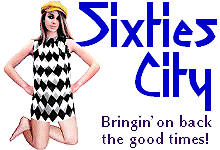

 |

|
|
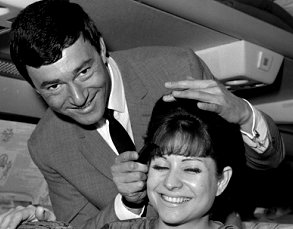 |
Sixties
Hairdressing The top name in hairdressing during the Sixties was undoubtedly Vidal Sassoon whose customers included Mary Quant, Jean Shrimpton and Mia Farrow who he famously flew to America for, when she wanted her hair styled, while she was on set making ' the film Rosemary's Baby'. Born in the East End of London in 1928, he had worked for 'Teazy Weazy' Raymond until 1955 and by the time the swinging Sixties arrived he had his own salon in New Bond Street. Creations of his included the 'bob cut', the 'five point geometric cut' - the neat swinging line as used by Mary Quant and Nancy Kwan, the 'One-eyed girl', the 'Asymmetric Isadora cut' and the 'Greek goddess' styles. These 'modern' hairdos had taken over from the popular but troublesome 'beehive' style . In this, the hair was back-combed to give it massive height and volume, styled, and then set in place using huge amounts of hair lacquer. Together with stiletto heels it could make a girl look up to a foot taller than she really was! Styles for women varied considerably, new 'cuts' being created on a regular basis covering a very wide variety of 'looks', but settling down to the simpler, long, shoulder length ( or longer ) hairstyles of the mid to late Sixties, via the chin-length heavily fringed or centre-parted Mod look. Another name associated with Sixties hairdressing under yet another name - Christian St. Forget - was Justin de Villeneuve (real name Nigel Jonathan Davies) who was probably more famous for his 'discovery' of, and relationship with, the fifteen year old Neasden girl Lesley 'Twiggy' Hornby. Born in London's East End and a genuine 'Cockney', Justin was evacuated to a Herefordshire manor house during World War 2 where he was a guest of writer J.B.Priestley. He went on to become a photographer, collaborating on pictures with Klaus Voorman (who created the Beatles 'Revolver' cover) and Erte. He photographed Henri Lartigue in 1968, and created the Marsha Hunt 'silhouette' poster. |
 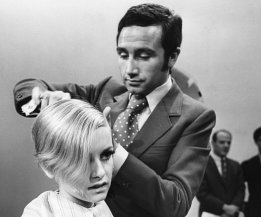 Leslie Cavendish Lawrence Falk Vidal Sassoon Bond Street Leonard of Mayfair |
Leslie
Cavendish left school at 15 and, with no particular career in mind, decided
to get into hairdressing after meeting his mother at her hairdresser's.
On a friend's advice (Lawrence Falk who opened 'Crimpers', thought to be
the first unisex salon in the U.K. in Baker Street) he sought an apprenticeship
at Vidal Sassoon's salon at 171 New Bond Street, later moving to the new
salon at the Grosvenor hotel, and completed his apprenticeship in only two
years. A client of his at Vidal's was Jane Asher who one day asked him to
cut her boyfriend's hair (Paul McCartney). After Dandie Fashions at 161
Kings Road, Chelsea, was taken over by Apple Tailoring 1968, the basement
was converted into a hairdressing salon which was run by Leslie. Leslie Cavendish - Beatles Hairdresser (Also see 'New Books' for Leslie's autobiography - Sept 2017) |
|
Twiggy's
boyish 'crop' hairstyle was actually created by Len Lewis who was better
known as 'Leonard of Mayfair'. Twiggy recalls: "I’d been told modelling would be difficult because I was so small. I was 5ft 6-and-a-half, but I wanted to get some test headshots done so I’d gone to have my hair set by Leonard at House of Leonard. I was only supposed to have it shampooed and styled but when he saw me he said ‘Can I try my new haircut on you?’. I had long hair so it was quite a shock when he cut it all off because it was very, very short but quite honestly, I was a little girl having my hair done for free in a very posh salon in Mayfair, so I balanced up the odds. If I’d said ‘you can’t cut my hair’ then nothing would have been as it has been." Leonard also takes the credit for creating the 'mop top' style of The Beatles who were brought to him by Brian Epstein after their Hamburg performances in Germany in order to 'smarten up' their image. Len had been a protégé of Vidal Sassoon and, working with colourist Daniel Galvin, his own salon at 6 Upper Grosvenor Street saw many famous visitors including Judy Garland, Liz Taylor and even John F. and Jackie Kennedy when they were in town. The 'In' hairdresser for mod males in the early to mid Sixties was John Anthony's salon in Twickenham. Hair styles for men gradually lengthened as the decade progressed, through the 'mop-top Beatle' style, the raised-back Mod style and the longer, more casual 'Rolling Stones' style to the shoulder length hair favoured by the hippies of the later Sixties, often worn in permed 'Afro' style. Wallace Scowcroft (President of The National Hairdressers Federation) said at the 1964 national conference: "Men's hairdressers do not object to youth wanting to wear its hair long, provided it is shaped. It would be out of step with modern times to oppose long hair because the hairdresser fears it will lead to fewer visits to his salon. We shall get all the business we want by ensuring that the Mods, the Rockers and the Beatles fans are well-groomed." Keith Wainwright started a five-year apprenticeship in 1959 followed by a year on the Union Castle liners. In 1965, he began working for Leonard ladies salon in London's West End and is credited with starting one of the first men's hairdressers catering for |
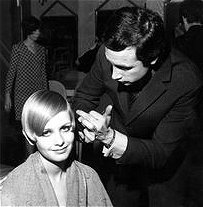 |



                 |
| The
'Beehive' hairdo was created in Chicago U.S.A. in February 1960 when the
editor of 'Modern Beauty Shop' magazine challenged Margaret Heldt, a hairstyling
champion and owner of an upmarket hair salon, to come up with "something
really different" for the decade ahead. Taking inspiration from a favourite
velvet fez, she wound long hair on large rollers and backcombed it into
a large bouffant. It was then wrapped around the head and fixed in place
with a significant application of hairspray. For a final touch, Margaret
Heldt pinned a small bee-shaped decoration in the model's hair, prompting
a writer from the magazine to name the effect a "beehive". 'Modern Beauty
Shop' described it as 'a tall wrap-around crown, creating a circular silhouette',
and it was an instant success. Women with pixie cuts turned up at Margaret
Heldt's salon with hair pieces that they wanted to be made into an 'artificial'
beehive. The style was also in great demand among the models and showgirls
who were very self-conscious about their height, its extra inches giving
them an 'edge' over their rivals. Although looking elaborate, it actually
kept in place without a salon 'touch-up' for about a fortnight and women
even took to wrapping their heads in a scarf or lavatory paper at bedtime
to hold the shape for even longer. Margaret Heldt was conservative about
the style's durability, saying: "I used to tell my clients: 'I don't care
what your husband does from the neck down, but I don't want him to touch
you from the neck up". The 'Bouffant' was one of the more popular women's hairstyles during the Sixties, probably most famously seen on Brigitte Bardot and Jackie Kennedy. The creation is credited to British hairdresser Raymond 'Teazie-Weazie' Bessone. Vidal Sassoon is reported as saying that he learned everything there is to learn about cutting hair from Raymond when he was his apprentice. |
|
Memories
of the Sixties Hairdressing Scene
featured by kind permission of Leon Simmons |
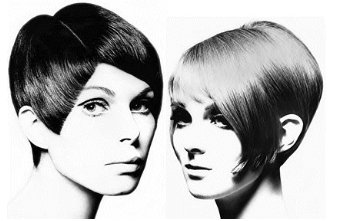 |
My father, Albert Simmons, and his partner
Professor Leonard Stein (one of the very rare professorships ever awarded
by the fellowship of Ladies Hairdressers) ran a then well-known and fashionable
ladies hairdressing salon in Marble Arch known as 'Romaine's of Park West'.
This was the breeding ground for the hair fashion revolution pioneered by
Vidal Sassoon, who worked for my father and recalls being interviewed for
a job in his first autobiography 'Sorry I Kept You Waiting, Madam'. In Romaine's were a remarkable team of creative fashion hairstylists who had some influence on Vidal's creativity (Vidal would have acknowledged that fact) and some of them became international names in high fashion ladies' hairdressing. There was Harold Leighton (Harrods), Gerard Saper, the brothers Philip and Gerald Belchak, plus a number of others who distinguished themselves later on with their own enterprises. Before running the Harrods ladies' hairdressing salon, Harold Leighton attended to numerous internationally famous stars and featured in many fashion magazines - he also wrote two illustrated best sellers on how to cut your own hair. He is still, I believe, an international consultant on hair and cosmetics. My father assisted Vidal in moving to a leading High Fashion Ladies Hairdressers in Albermarle Street (can't remember the name). They drove him crazy by booking him up with too many clients at a time and he couldn't handle the pressure (he threw his tools in the air and walked out). From there, as I recall, he went to Raymond 'Mr Teazie Weazie' Bassone. Raymond was a great cutter of hair but used to conceal his technique of cutting by working in cubicles with his clients and starting at different parts of the head to confuse anyone watching him. According to my father, it took a long time for Vidal to absorb Raymond's cutting technique (I have repeated this story to Vidal and he confirmed that Raymond was secretive about his cutting techniques). He used to ring my Dad and tell him about the problems he was having--but he eventually rang him up and said "I've got it!" |
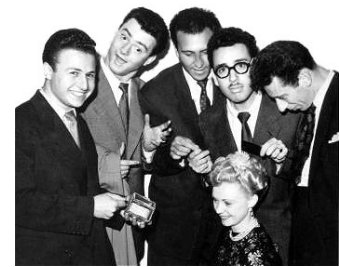 The staff at Romaine's of Park West Salon in 1948. Vidal Sassoon is 2nd from left, Gerard Saper 3rd and Harold Leighton 4th. |
Raymond, who was somewhat theatrical, would sometimes hold his head in his hands and pace up and down the salon in front of a long line of clients sitting under the driers. Eventually, one of the women would try to attract his attention, possibly touching his sleeve as he walked by, and attempt to talk to him. Raymond would appear outraged and would say, "Madam, can you not see that I am meditating!" All pretentious rubbish of course, but in those days that kind of camp nonsense was part of the ridiculous image that Mayfair Ladies hairdressers used to project their 'importance'. So it was at Raymond's where Vidal probably mastered his fabulous hair cutting technique. But there was one thing missing: the technique of using the brush to dress out the hair. The master of that technique was 'French of London' in Curzon Place. The inventor of the technique was Freddie French himself. I know this because I started my career as a stylist in this salon. So Vidal had the cutting skills and French owned the brushing out technique. |
||
|
Now, as I understand
it, one of the managers of the French salon eventually went to work for
Vidal Sassoon or at least swapped his technique of brushing (dressing hair)
for Vidal's technique of cutting. It was the marriage of the two most important
techniques in High Fashion Ladies hairdressing that assisted Vidal to create
those wonderful hairstyles. Justin DeVilleneuve was never ever in any shape or form a top hairdresser. Nigel Davies, as I knew him, was a junior (shampooist and under tuition) at Vidal Sassoon in the 60's. This was about the same time I was also working as a junior hairdresser at another salon in Mayfair. He was employed for a couple of summer seasons at my father's salon in Torquay and was a remarkably untalented stylist but was a bit of a showman. Vidal was a great buddy of my Dad and used to send juniors to Torquay to get experience in this busy salon. I knew Nigel quite well at that time and I was astonished that he became so successful. When I spoke to Vidal Sassoon many years ago he too was amazed, but was warm in his praise for Nigel's achievements. Best regards, copyright Leon Simmons 2017 |
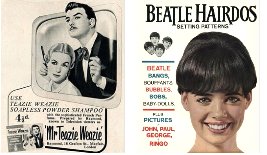 |
Excerpt
from Vidal Sassoon's autobiography, reminiscing about Romaine's and his
own memories of Albert Simmons. Mark Hayes, Sassoon International creative director: “My life as a young apprentice learning hairdressing started in 1950 at a salon named Romaine's of Park West in central London, a stone’s throw away from Marble Arch. Vidal happened to join the salon around a year after I did when he came out of fighting the war in Israel. “I was in the right place (salon) at the right time and I was a very lucky young man as it turned out. I had the thrill and pleasure to learn my craft in two salons that we worked at together as mates. “Vidal, Gerard and Harold were known as the Three Musketeers. We were trained by some wonderful, dedicated people including Leslie and Connie Green, Frank Blashke, Morrie Gross, Len Stein, Albert Simmons and Gerry London (the third musketeer) and so many more names to fill a book!" Recreating Sixties and Vintage Hair Styles How to create a Beehive How to create a Bouffant How to create a 'Bun' Updo |
|
|
All
Original Material Copyright SixtiesCity
Other individual owner copyrights may apply to Photographic Images |